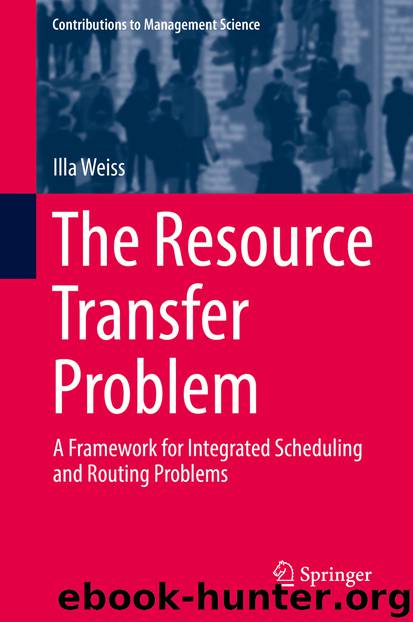The Resource Transfer Problem by Illa Weiss

Author:Illa Weiss
Language: eng
Format: epub
ISBN: 9783030025380
Publisher: Springer International Publishing
4.3 Integrated Scheduling and Routing Problems as Resource Transfer Problems
In many practical applications, scheduling and routing decisions are interdependent and thus planning should not be separately undertaken. Consequently, the integrated problem does not only involve scheduling of operations or activities, but will additionally include transportation tasks or other customer services to be performed by vehicles. Basically, all the problems described in Sects. 4.1 and 4.2, including the additional constraints, can be combined to represent an integrated problem. In the resource transfer problem, we model the machine scheduling part as described in Sect. 4.1.1, the project scheduling part as explained in Sect. 4.1.2, and the vehicle routing part as discussed in Sect. 4.2 for the problem in question. Thus in the integrated problem, pairs of events may represent operations, activities, or customer services. Of course the events may be associated with different locations if necessary. The transfer times may, for example, refer to setup or changeover times, travel times among different locations, and durations of operations, activities, or customer services. The elements of the machine and project scheduling part and the vehicle routing can be connected by defining synchronization and coordination requirements. For instance, perishability of goods can be taken into account by defining maximum time lags between events representing the production and the delivery of the respective goods. Moreover, transfer times among multiple production plants and customer locations may be defined. Of course we may also introduce unit-inclusion or unit-incompatibility constraints among events belonging to different subproblems. In this way, we can formulate integrated problems for joint planning of supply chain operations, which may comprise multiple production plants, delivery of goods to or between customer locations, recollection of goods, perishability and short shelf-lives of different products, intermediate storage at storage facilities with limited capacity, and many more factors.
For example, we could envisage a supply chain comprising several tiers with several suppliers, an OEM (Original Equipment Manufacturer), and distributors. The OEM produces a final product which is delivered to the distributors. For production, the OEM requires intermediate products which are provided by the suppliers. The OEM and the suppliers may decide on alternative process plans for the production of the final and the intermediate products. The delivery of intermediate products from the suppliers to the OEM and the delivery of final products from the OEM to the distributors will be carried out using heterogeneous vehicles, where the distributors must be served within prescribed time windows. Moreover, the intermediates may be stored in warehouses at the locations of the suppliers and the OEM, and the final products can be stored at the locations of the OEM and the distributors. The tasks to be performed at the respective locations correspond to the execution of production orders or the loading and unloading of vehicles. To perform the production orders, machines and workers are required, whereas for loading and unloading handling facilities and workers are required. In the resource transfer problem, each task is represented by a pair of start and completion events. The vehicles
Download
This site does not store any files on its server. We only index and link to content provided by other sites. Please contact the content providers to delete copyright contents if any and email us, we'll remove relevant links or contents immediately.
Bad Blood by John Carreyrou(6578)
Rich Dad Poor Dad by Robert T. Kiyosaki(6500)
Principles: Life and Work by Ray Dalio(6289)
Playing to Win_ How Strategy Really Works by A.G. Lafley & Roger L. Martin(6066)
Management Strategies for the Cloud Revolution: How Cloud Computing Is Transforming Business and Why You Can't Afford to Be Left Behind by Charles Babcock(4543)
The Confidence Code by Katty Kay(4210)
Thinking in Bets by Annie Duke(4177)
American Kingpin by Nick Bilton(3808)
Delivering Happiness by Tony Hsieh(3391)
Project Animal Farm: An Accidental Journey into the Secret World of Farming and the Truth About Our Food by Sonia Faruqi(3187)
The Power of Habit by Charles Duhigg(3088)
Brotopia by Emily Chang(3023)
The Tyranny of Metrics by Jerry Z. Muller(3022)
Mastering Bitcoin: Programming the Open Blockchain by Andreas M. Antonopoulos(3004)
The Marketing Plan Handbook: Develop Big-Picture Marketing Plans for Pennies on the Dollar by Robert W. Bly(3000)
I Live in the Future & Here's How It Works by Nick Bilton(2954)
The Content Trap by Bharat Anand(2883)
Applied Empathy by Michael Ventura(2862)
Building a StoryBrand by Donald Miller(2861)
